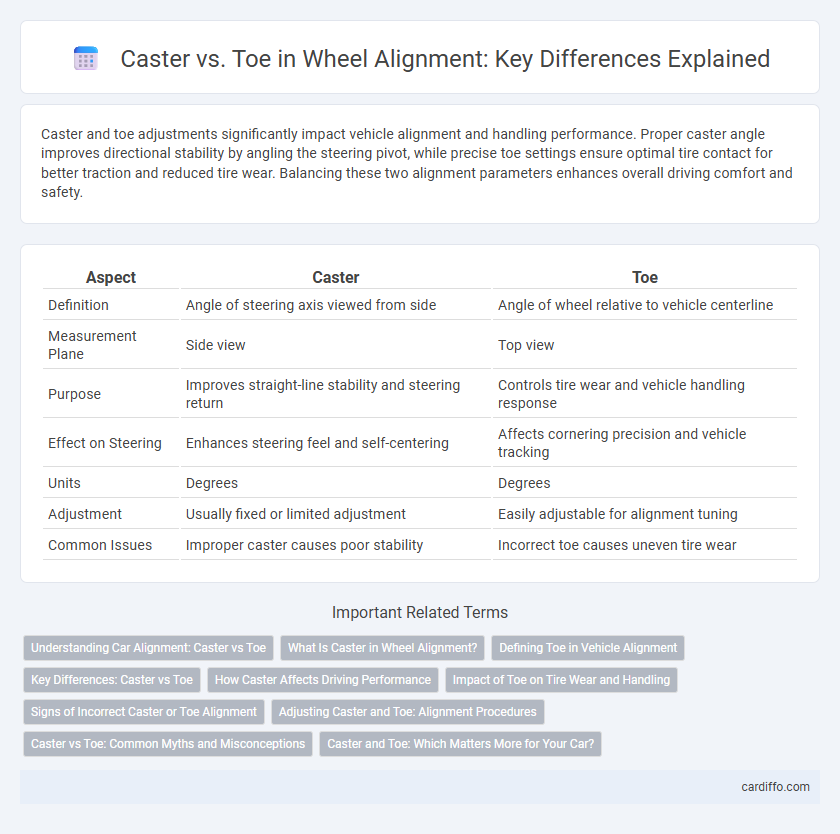Caster and toe adjustments significantly impact vehicle alignment and handling performance. Proper caster angle improves directional stability by angling the steering pivot, while precise toe settings ensure optimal tire contact for better traction and reduced tire wear. Balancing these two alignment parameters enhances overall driving comfort and safety.
Table of Comparison
| Aspect | Caster | Toe |
|---|---|---|
| Definition | Angle of steering axis viewed from side | Angle of wheel relative to vehicle centerline |
| Measurement Plane | Side view | Top view |
| Purpose | Improves straight-line stability and steering return | Controls tire wear and vehicle handling response |
| Effect on Steering | Enhances steering feel and self-centering | Affects cornering precision and vehicle tracking |
| Units | Degrees | Degrees |
| Adjustment | Usually fixed or limited adjustment | Easily adjustable for alignment tuning |
| Common Issues | Improper caster causes poor stability | Incorrect toe causes uneven tire wear |
Understanding Car Alignment: Caster vs Toe
Caster affects the steering stability by controlling the angle of the steering pivot, which influences how the wheels track straight and return to center after a turn. Toe alignment refers to the angle at which the tires point inward or outward when viewed from above, impacting tire wear and vehicle handling responsiveness. Proper adjustment of both caster and toe is essential for optimal driving performance, tire longevity, and safe vehicle dynamics.
What Is Caster in Wheel Alignment?
Caster in wheel alignment refers to the angle of the steering axis when viewed from the side of the vehicle, measured in degrees. It affects the vehicle's stability, steering effort, and cornering performance by influencing how the wheels return to the straight-ahead position after turning. Proper caster adjustment improves straight-line tracking and enhances overall driving comfort.
Defining Toe in Vehicle Alignment
Toe in vehicle alignment refers to the angle at which the wheels point inward or outward when viewed from above, affecting tire wear and handling. Proper toe settings ensure the wheels run parallel or slightly angled to optimize stability and steering response. Incorrect toe can lead to uneven tire wear and decreased fuel efficiency.
Key Differences: Caster vs Toe
Caster angle refers to the tilt of the steering axis in relation to the vertical axis viewed from the side, influencing vehicle stability and steering feel. Toe describes the direction the wheels point relative to the vehicle's centerline when viewed from above, affecting tire wear and cornering response. The key difference lies in caster controlling directional control and steering return, while toe primarily impacts tire alignment and vehicle handling precision.
How Caster Affects Driving Performance
Caster angle impacts steering stability and cornering performance by determining how the wheels return to the straight-ahead position after a turn. Positive caster enhances high-speed stability and improves handling responsiveness, reducing driver effort and front-wheel "wandering." Improper caster settings can cause uneven tire wear and impair vehicle tracking, leading to decreased safety and comfort.
Impact of Toe on Tire Wear and Handling
Toe misalignment causes uneven tire wear, especially accelerating wear on the inner or outer edges, reducing tire lifespan by up to 30%. Improper toe settings compromise vehicle handling, leading to increased steering effort, reduced stability, and unpredictable cornering behavior. Correct toe adjustment improves tire contact with the road surface, enhancing grip and overall driving safety.
Signs of Incorrect Caster or Toe Alignment
Uneven tire wear and poor steering response are common signs of incorrect caster alignment, which can cause the vehicle to pull to one side or exhibit unstable directional control. Incorrect toe alignment typically results in feathered or scalloped tire tread patterns and a noticeable vibration in the steering wheel at higher speeds. Both misalignments can lead to decreased fuel efficiency and compromised vehicle handling safety.
Adjusting Caster and Toe: Alignment Procedures
Adjusting caster and toe during wheel alignment involves precise measurements to ensure optimal vehicle handling and tire wear. Caster angle adjustments are made by altering the position of suspension components, affecting steering stability and cornering performance. Toe settings are fine-tuned by adjusting tie rods or control arms, correcting directional control and minimizing tire scrubbing for improved efficiency.
Caster vs Toe: Common Myths and Misconceptions
Caster and toe are often confused in vehicle alignment, but caster refers to the angle of the steering axis viewed from the side, while toe is the angle the tires point inward or outward when viewed from above. A common misconception is that caster directly affects tire wear, but toe alignment primarily influences tire wear and handling stability. Proper differentiation and adjustment of caster and toe angles are crucial for optimal vehicle performance and safety.
Caster and Toe: Which Matters More for Your Car?
Caster angle significantly impacts vehicle stability and steering feel by controlling the direction and returnability of the front wheels, crucial for maintaining straight-line tracking and reducing driver fatigue. Toe alignment, defined by the inward or outward angle of the wheels, directly influences tire wear and cornering performance, making precise adjustments vital for balanced handling. While both caster and toe angles are essential, toe settings generally matter more for everyday tire longevity and immediate handling responsiveness, whereas caster primarily enhances long-term driving stability and steering effort.
Caster vs Toe Infographic

 cardiffo.com
cardiffo.com